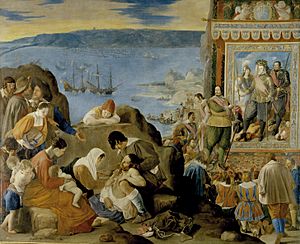The Recovery of Bahía de Todos los Santos facts for kids
Quick facts for kids The Recovery of Bahía de Todos los Santos |
|
|---|---|
 |
|
| Artist | Juan Bautista Maíno |
| Year | 1634–1635 |
| Medium | Oil on canvas |
| Dimensions | 309 cm × 381 cm (122 in × 150 in) |
| Location | Museo del Prado, Madrid |
The Recovery of Bahía de Todos los Santos is a famous painting by the Spanish artist Juan Bautista Maíno (1580–1649). He painted it between 1634 and 1635. The painting shows an important historical event: the recapture of the city of Salvador da Bahia in Brazil.
In May 1625, Spanish and Portuguese forces took Salvador da Bahia back from the Dutch. At that time, Spain and Portugal were united under one king, in what was called the Iberian Union. The painting celebrates this victory. It was first displayed in a special room called the Salón de Reinos in Madrid. Today, you can see it in the Prado Museum in Madrid.
What the Painting Shows
This painting is special because it does not just show a simple victory. Instead, it also shows the sadness and pain that war brings.
The Story in the Painting
On the right side of the painting, you can see Fadrique Álvarez de Toledo y Mendoza, who led the forces that won the battle. He points towards a special portrait of King Philip IV of Spain (who was also King Philip III of Portugal). In this portrait, the king is shown stepping on figures that represent War, Anger, and false beliefs. A figure named Victoria (who represents victory) places a crown of leaves on the king's head. Next to the king is the Conde-Duque de Olivares, a very important helper to the king.
After the Battle
In front of the king's portrait, some people are celebrating the victory. But in the main part of the painting, you can see what happened after the battle. There are men, women, and children gathered around a wounded soldier. They are helping him and watching over him. This part of the painting shows feelings like kindness, helping others, and the suffering that war causes.
See also

